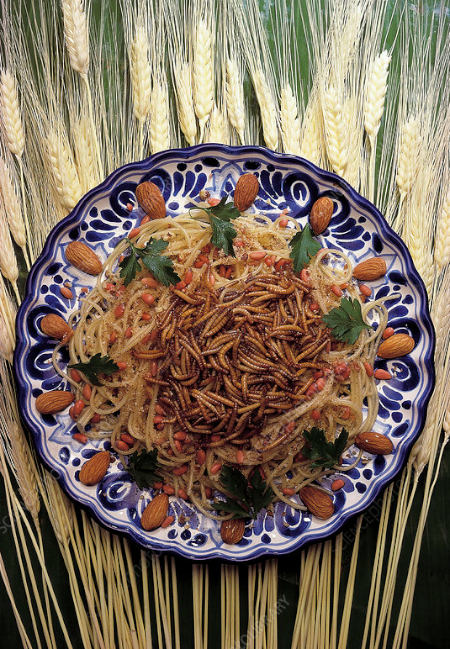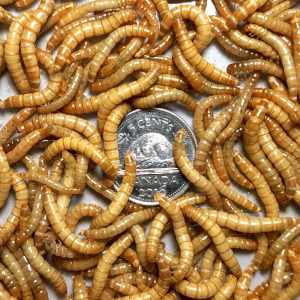The folks at ÉcoDélys in Montreal are betting the farm on it – their mealworm farm, that is. The fledgling firm is just the latest to go all-in growing high-protein bugs that they and others are calling ‘the food of the future’…

We’ve talked before about groundbreaking entrepreneurs producing insects as livestock and human food. Most of the chatter has been about crickets. That may be because they are already enjoyed (and have been for ages) by Asian street food lovers. Now, they’re getting special attention from occidental farmers.
And mealworms are starting to gain traction.
Why insects?
As mentioned earlier, many Asian culinary cultures count insects as staples. But I was shocked at how many people are counted in that cohort!
As Wikipedia relates: “Over 2 billion people are estimated to eat insects on a daily basis. Globally, more than 2,000 insect species are considered edible, though far fewer are discussed for industrialized mass production and regionally authorized for use in food. Many insects are highly nutritious, though nutritional content depends on species and other factors such as diet and age.
“Insects offer a wide variety of flavors and are commonly consumed whole or pulverized for use in dishes and processed food products such as burger patties, pasta (see photo, above left), or snacks. Like other foods, there can be risks associated with consuming insects, such as allergic reactions.“
One hundred grams of dried crickets provides more than 69 g of protein. The same amount of meal worms delivers more than 45 g.
How are they prepared?
Insects for human consumption are typically fried as street food. Millions of diners around the world consider them a crunchy snack of choice, buttered or coated with sugar. They may also be dried and crushed, or pulverized as flour. Commercial producers often freeze-dry them before proceeding to further processing steps.
Insects are already incorporated in a variety of products you can get in specialty shops or order on the internet:
- Insect Protein Bars: Brands Incorporating Cricket Flour
- Insect Pasta: Brands Mixing in Cricket Flour
- Insect Snacks & Cookies
- Insect Protein Shakes
- Waffle, Pancake and Cookie Mixes
- Seasoning and Spreads
- Insect Candies
- Insect Beer and Liquor
And that’s just a start… Insectgourmet.com provides as compol;ete a rundown as I’ve yet.
Insect recipes abound!
A quick Google of ‘insect recipes’ returns more than 37.6 million hits. Of special interest to those new to insects dining will be the ‘beginners’ selection at Yumbug.com.
Would you try…
- Cricket ‘Bacon’ Carbonara
- Buffalo Worm & Sweetcorn Fritters
- Sticky Teriyaki Cricket Bao Buns
- Cricket & Kale Pesto Rigatoni
- Smoky BBQ Cricket Tacos
- Teriyaki Crickets & Pak Choi with Rice
- Buffalo Worm Cauliflower Wings
- Fluffy Buffalo Worm Pancakes
- Spiced Cricket Tarka Dhal
- Creamed Kale & Rosemary Cricket Toast
Don’t let difficulty finding the ingredients deter you. Yumbug.com provides a shopping experience on Amazon. And a whole host of companies are offering almost 350 insect food products there, as well.
Mealworm breakout
As we teased earlier, ÉcoDélys in Montreal – which only started up a year and half ago – is already growing 25 metric tonnes of mealworms annually.
Rather than going in at ground level, attempting to flog bugs as street-level food and household commodities, they’re marketing their own brand of mealworm paté. The psychology is that folks will be more likely to try insects in the guise of an exclusive net gourmet food. And if you didn’t know they were in their, you’d never guess the paté was insect-based. Alas, it’s priced at $12 for a small jar.
“Of course the yuck factor is still out there, for sure,” said Sylvain Charlebois, Dalhousie University’s Director of the Agri-food Analytics told Global News. He agrees that consumers will more readily accept insect-based foods of they don’t see the insects. “More and more people are looking at insects as a source of protein – but as an ingredient embedded in products.”
My take
I think one of the most clever moves by ÉcoDélys is to ensure that the word ‘insect’ and ‘mealworm’ don’t appear on the paté’s label. Instead, they’re marketing it as ‘Tenebrion Gourmand’, which loosely translates as ‘Gourmet Mealworm’. I’ll be content to wait and see if the ‘don’t see the insects’ ploy works.
Meanwhile, prices will have to come down through mass production before mealworms or crickets become mainstream protein sources. But boosters say insects are so easy and cheap to raise, they’ll come in eventually well below the current costs of meat.
One more thing… ÉcoDélys feeds its mealworms on brewery byproduct – the mash left over after beer yeast has extracted the sugar from sprouted barley and turned it into alcohol. Kudos for the mealworm farmers for creating a fully circular food production process!
~ Maggie J.

